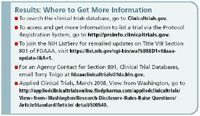Data Disclosure Clears FDAAA Deadline
An in depth look at industry's reaction to FDAAA, its requirements, submitting the results, and meeting the deadline.
When FDAAA was enacted last year, the Clinical Trial Databases section of the Act called for a three-year timeline of requirements toward furthering clinical trials reporting on the Web. September 27 was the deadline for sponsors to provide reporting of basic results on www.clinicaltrials. gov.
"This deadline is causing some angst," Tim Bacon, CEO of Newtown, PA-based PeerView, said prior to the deadline. "With the results requirement, sponsors are required to disclose very granular results data within one year of completion of final collection of data for the primary outcome—a data point that most sponsors were not even tracking prior to FDAAA."
The results requirements include demographic and baseline characteristics of the study participants, results values for each of the primary and secondary outcomes for each arm of the study, point of contact for scientific queries, and information on sponsor agreements with investigators that could restrict their ability to discuss or publish trial results. What makes the results requirement most complicated is the format in which the results must be submitted: Rather than uploading study results that have already been compiled into a clinical study report for example, using www.ClinicalTrial.gov's online Protocol Registration System (PRS), sponsors must first create results tables and then enter the data and statistical analyses.

Results: Where to Get More Information
Adding the results to the trial listing increases the transparency of the drug development process to the public, which is what the Act intended. Stiff penalties and fines can be levied against sponsors who do not comply with FDAAA and its deadlines. Even if sponsors have results listed on their Web page, or in another like repository such as ClinicalStudy Results.org, they are still required to post to www.clinicaltrials.gov. "Of the top pharma and biotech companies (by revenue) we surveyed," said Bacon, "seven out of 10 had links to results on their own page."
As our Washington columnist Jill Wechsler reported in March of this year, the December 26, 2007, deadline for the clinical trials listings requirement led to a doubling of new trial registrations from 250 to nearly 500 a week. Other studies already registered had to be modified to include the additional required data sets.
Bacon, whose company provides an interface application that helps with this registration process, says that FDAAA and its requirements are only one part of the disclosure picture. "The biggest red flag on the horizon is what's going on in the rest of the world. There is a growing number of other countries that are evaluating mandatory registries such as this," explains Bacon. "But what data are they going to require? In what language? And how will it be posted?"
So while the global regulatory outlook on disclosure is an unknown to sponsors, they are still developing internal processes to deal with the known. "Some will develop internal groups or applications to deal with the data requirements," said Bacon. Others may turn to companies such as PeerView to help struggle through the next stages of FDAAA disclosure requirements. According to Bacon, VCTR (the Veritas Clinical Trial Register) system helps standardize the process, and helps with the data creation and capture needed to feed into clinicaltrials.gov.
"PRS is a bit of a perfectionist," comments Bacon. "It only accepts certain characters and rejects others." The PeerView system features error and fact checking so that data can be accurately inputted. The system manages the process by taking a regularly scheduled feed from the sponsor or CRO—or both—CTMS, multiple CTMS can be handled. This information is then fed into the backend of the VCTR to create data sets that can be standardized to www.clinicaltrials.gov and ClinicalStudyResults.org, and routed to the various internal authorities (IP, legal, SOPs) for approval, and then posts it to the public registries on the sponsors behalf. "This helps because the various clinical teams may be using different language and this can standardize their wording and process," says Bacon.
The next deadline for Clinical Trial Databases? March 2009, which calls for listing information on serious and frequent adverse events.—Lisa Henderson

Improving Relationships and Diversifying the Site Selection Process
April 17th 2025In this episode of the Applied Clinical Trials Podcast, Liz Beatty, co-founder and chief strategy officer, Inato, discusses a number of topics around site engagement including community-based sites, the role of technology in improving site/sponsor relationships, how increased operational costs are impacting the industry, and more.
Behind the Buzz: Why Clinical Research Leaders Flock to SCOPE Summit
February 7th 2025In this episode, we meet with Micah Lieberman, Executive Conference Director for SCOPE Summit (Summit for Clinical Ops Executives) at Cambridge Innovation Institute. We will dive deep into the critical role of collaboration within the clinical research ecosystem. How do we bring together diverse stakeholders—sponsors, CROs, clinical trial tech innovators, suppliers, patients, sites, advocacy organizations, investors, and non-profits—to share best practices in trial design, program planning, innovation, and clinical operations? We’ll explore why it’s vital for thought leaders to step beyond their own organizations and learn from others, exchanging ideas that drive advancements in clinical research. Additionally, we’ll discuss the pivotal role of scientific conferences like SCOPE Summit in fostering these essential connections and collaborations, helping shape the future of clinical trials. Join us as we uncover how collective wisdom and cross-industry partnerships are transforming the landscape of clinical research.
FDA-Approved Gene Therapy Beqvez Shows Sustained Efficacy, Safety in Long-Term Hemophilia B Trial
April 17th 2025Beqvez (fidanacogene elaparvovec), an FDA-approved one-time gene therapy for hemophilia B, demonstrated sustained factor IX expression, low bleeding rates, and a favorable safety profile over long-term follow-up.